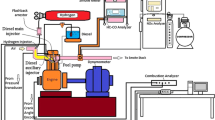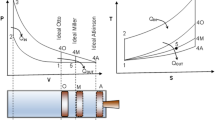Abstract
In-cylinder charge density at top dead center is an important parameter of diesel engines and is influenced by intake pressure, intake temperature, and compression ratio. The effects of charge density on fuel spray, combustion process, and emissions were investigated by using a constant volume bomb and a heavy-duty diesel engine. Spray development resistance increased with the increase of the charge density in the constant volume bomb. It was found that short spray penetration was accompanied by a large spray cone angle in the former stage with high charge density. However, the equivalence ratio was lowered and the degree of homogeneity of the mixture was increased in the later stage owing to the rapid interaction of fuel and gas at a high mixing rate. Combining the first law of thermodynamics and the second law of thermodynamics for analysis, as the charge density increased, the gross indicated thermal efficiency (ITEg) was improved. However, pumping loss had to be considered with higher charge density. Under this condition, the brake thermal efficiency (BTE) trend was increased initially and decreased subsequently. Under high-load operation (1200 r/min BMEP, 2.0 MPa), the minimum charge density value of 44.8 kg/m3 was found to be reasonable. This charge density was suitable for combustion and brought about minimum exhaust energy and trade-off emissions. Moreover, by analyzing two operation conditions in terms of the maximum BTE with the Miller and the conventional cycles, compression temperature and combustion temperature were reduced in the Miller cycle with the charge density 44.8 kg/m3. A high Cp/Cv could improve the cylinder exergy/power conversion process by its positive effect of increasing the specific heat ratio. Owing to the interaction between a high Cp/Cv and exergy loss to heat transfer, the condition with the minimal charge density could produce more piston work.
Similar content being viewed by others
Abbreviations
- BMEP:
-
brake mean effective pressure
- BTE:
-
brake thermal efficiency
- CO:
-
carbon monoxide
- EGR:
-
exhaust gas recirculation
- HC:
-
hydrocarbon compounds
- HCCI:
-
homogeneous charge compression ignition
- IMEP:
-
indicated mean effective pressure
- IVCT:
-
intake valve closing timing
- ITEg:
-
gross indicated thermal efficiency
- LIVC:
-
late intake valve closing
- LTC:
-
low temperature combustion
- Φ :
-
equivalence ratio
- NOx :
-
nitrogen oxides
- PPC:
-
partial premix combustion
- ROHR:
-
rate of heat release
- RCCI:
-
reaction controlled compression ignition
- TDC:
-
top dead center
- VGT:
-
variable geometry turbine
- p:
-
pressure
- v:
-
volume
References
Agarwal, A. K., Srivastava, D. K., Dhar, A., Maurya, R. K., Shukla, P. C. and Singh, A. P. (2013). Effect of fuel injection timing and pressure on combustion, emissions and performance characteristics of a single cylinder diesel engine. Fuel, 111, 374–383
Al-Dawody, M. F. and Bhatti, S. K. (2013). Optimization strategies to reduce-the biodiesel NOx effect in diesel engine with experimental verification. Energy Conversion and Management, 68, 96–104
Abdelaal, M. M. and Hegab, A. H. (2012). Combustion and emission characteristics of a natural gas-fueled diesel engine with EGR. Energy Conversion and Management, 64, 301–312
Adachi, T., Aoyagi, Y., Kobayashi, M., Murayama, T., Goto, Y. and Suzuki, H. (2009). Effective NOx reduction in high boost, wide range and high EGR rate in a heavy duty diesel engine. SAE Paper No. 2009–01-1438
Colban, W. F., Miles, P. C. and Oh, S. (2007). Effect of intake pressure on performance and emissions in an automotive diesel engine operating in low temperature combustion regimes. SAE Paper No. 2007–01-4063
Gonca, G., Sahin, B., Parlak, A., Ust, Y., Ayhan, V., Cesur, İ. and Boru, B. (2015). Theoretical and experimental investigation of the miller cycle diesel engine in terms of performance and emission parameters. Applied Energy, 138, 11–20
Heywood, J. B. (1988). Internal Combustion Engine Fundamentals. 1st edn. McGraw-Hill. New York, USA.
Jayashankara, B. and Ganesan, V. (2010). Effect of fuel injection timing and intake pressure on the performance of a DI diesel engine–A parametric study using CFD. Energy Conversion and Management 51, 10, 1835–1848
Jia, M., Xie, M., Wang, T. and Peng, Z. (2011). The effect of injection timing and intake valve close timing on performance and emissions of diesel PCCI engine with a full engine cycle CFD simulation. Applied Energy 88, 9, 2967–2975
Kokjohn, S. L., Hanson, R. M., Splitter, D. A. and Reitz, R. D. (2011). Fuel reactivity controlled compression ignition (RCCI): A pathway to controlled high-efficiency clean combustion. Int. J. Engine Research 12, 3, 209–226
Mancaruso, E., Merola, S. S. and Vaglieco, B. M. (2008). Study of the multi-injection combustion process in a transparent direct injection common rail diesel engine by means of optical techniques. Int. J. Engine Research 9, 6, 483–498
Mikalsen, R., Wang, Y. D. and Roskilly, A. P. (2009). A comparison of Miller and Otto cycle natural gas engines for small scale CHP applications. Applied Energy 86, 6, 922–927
Murata, Y., Kusaka, J., Daisho, Y., Kawano, D., Suzuki, H., Ishii, H. and Goto, Y. (2008). Miller-PCCI combustion in an HSDI diesel engine with VVT. SAE Paper No. 2008–01-0644
Pickett, L. M. and Siebers, D. L. (2004). Soot in diesel fuel jets: Effects of ambient temperature, ambient density, and injection pressure. Combustion and Flame 138, 1–2, 114–135
Papagiannakis, R. G. (2013). Study of air inlet preheating and EGR impacts for improving the operation of compression ignition engine running under dual fuel mode. Energy Conversion and Management, 68, 40–53
Saxena, S. and Bedoya, I. D. (2013). Fundamental phenomena affecting low temperature combustion and HCCI engines, high load limits and strategies for extending these limits. Progress in Energy & Combustion Science 39, 5, 457–488
Sayin, C. and Canakci, M. (2009). Effects of injection timing on the engine performance and exhaust emissions of a dual-fuel diesel engine. Energy Conversion and Management 50, 1, 203–213
Sarangi, A. K., Mctaggart-Cowan, G. P. and Garner, C. P. (2010). The effects of intake pressure on high EGR low temperature diesel engine combustion. SAE Paper No. 2010–01-2145
Su, W., Lu, Y., Yu, W., Wang, C., Pei, Y., Sun, Y., Li, Y., Yu, Z. and Wang, J. (2009). High density-low temperature combustion in diesel engine based on technologies of variable boost pressure and intake valve timing. SAE Paper No. 2009–01-1911
Su, W., Su, T., Guo, H., Mao, L. and Xie, T. (2010). Quantitative study of concentration and temperature of a diesel spray by using planar laser induced exciplex fluorescence technique. SAE Paper No. 2010–01-0878
Su, W., Zhan, Q., Pei, Y., Liu, E. and Wu, S. (2013). Selfadaptive Hydraulic Variable Valve Timing System for Diesel Engine and Control Method. US 2013012584 A1
Su, W., Lin, T. and Pei, Y. (2003). A compound technology for HCCI combustion in a DI diesel engine based on the multi-pulse injection and the BUMP combustion chamber. SAE Paper No. 2003–01-0741
Tanaka, T., Ando, A. and Ishizaka, K. (2002). Study on pilot injection of DI diesel engine using common-rail injection system. JSAE Review 23, 3, 297–302
Tinschmann, D. I. G., Holand, D. I. P., Benetschik, D. I. H. and Eilts, D. I. P. (2008). Potential of two-stage turbocharging on MAN Diesel’s 32/4 CR. MTZ Worldwide 69, 10, 14–21
Thurnheer, T., Edenhauser, D., Soltic, P., Schreiber, D., Kirchen, P. and Sankowski, A. (2011). Experimental investigation on different injection strategies in a heavyduty diesel engine: Emissions and loss analysis. Energy Conversion and Management 52, 1, 457–467
Wu, B., Qiang, Z., Yu, X., Lv, G., Nie, X. and Liu, S. (2017). Effects of Miller cycle and variable geometry turbocharger on combustion and emissions in steady and transient cold process. Applied Thermal Engineering, 118, 621–629
Wakisaka, Y., Hotta, Y., Inayoshi, M., Nakakita, K., Sakata, I. and Takano, T. (2009). Emissions reduction potential of extremely high boost and high EGR rate for an HSDI diesel engine and the reduction mechanisms of exhaust emissions. SAE Int. J. Fuels and Lubricants 1, 1, 611–623
Wang, Y., Lin, L., Zeng, S., Huang, J., Roskilly, A. P., He, Y., Huang, X. and Li, S. (2008). Application of the miller cycle to reduce NOx emissions from petrol engines. Applied Energy 85, 6, 463–474
Wang, Y., Lin, L., Roskilly, A. P., Zeng, S., Huang, J., He, Y., Huang, X., Huang, H., Wei, H., Li, S. and Yang, J. (2007). An analytic study of applying miller cycle to reduce NOx, emission from petrol engine. Applied Thermal Engineering 27, 11–12, 1779–1789
Yoon, S. H. and Lee, C. S. (2012). Effect of undiluted bioethanol on combustion and emissions reduction in a SI engine at various charge air conditions. Fuel, 97, 887–890
Author information
Authors and Affiliations
Corresponding author
Rights and permissions
About this article
Cite this article
Wu, B.Y., Zhan, Q., Yu, X.Y. et al. Effect of Charge Density on Spray Characteristics, Combustion Process, and Emissions of Heavy-Duty Diesel Engines. Int.J Automot. Technol. 19, 605–614 (2018). https://doi.org/10.1007/s12239-018-0057-5
Received:
Revised:
Accepted:
Published:
Issue Date:
DOI: https://doi.org/10.1007/s12239-018-0057-5




